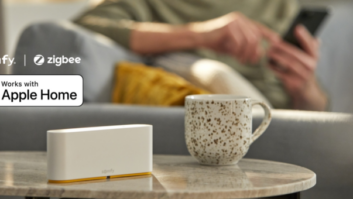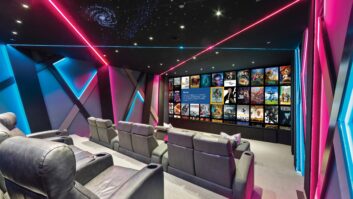NEW YORK –Home and aftermarket car audio suppliers haven’t completely dodged the bullet fired by Apple with the launch of the all-digital eight-pin Lightning connector on the iPhone 5 and new iPod Touch and Nano.
Audio suppliers are still testing their Made for iPod/ iPhone products for compatibility with Apple’s new devices, but theoretically, most of their Apple-certified products should be able to stream audio and metadata from the Apple devices, in some cases through the use of Apple-supplied adapters. Audio products designed to control the connected devices should also continue to do so.
At least one car audio supplier, however, has found that seven head units that should work with the Apple devices don’t. That company, Alpine, promises to uncover the root cause of the incompatibility.
On the home side of the audio business, an Apple spokesman said existing iPod/iPhone-docking speaker systems and docking tabletop stereos should stream audio from the docked Apple devices when used with Apple’s $29 Lightning-to-30-pin adapter plug or with a $39 Lightning-to-30-pin adapter cable.
Besides physically adapting the audio products’ 30-pin connector to the Apple devices’ eight-pin connector, the adapters incorporate a digital-to-analog converter (DAC) to convert the new Apple devices’ digital audio output to analog. That provides compatibility with the many docking tabletop audio systems that are engineered to capture audio in analog form from previous generations of Apple devices, the Apple spokesperson told TWICE. The new Apple devices, in contrast, send out audio only in digital PCM form over their Lightning connector. Previous iPod and iPhone generations spit out audio in both analog and digital form over their 30-pin connectors.
The adapters’ DAC is bypassed if the docking system is designed to capture Apple output in digital form, as many step-up systems do.
One downside to the adapters is their lack of support from streaming video from a connected Apple device, Apple said.
The only other issue for docking tabletop systems would be the physical stability of the new Apple devices when docked with the adapter plug and the space available on the docking system to accommodate the adapter.
“My only questions would be the stability of the iPhone — it looks as if it would sit a bit high on some speaker docks — and the width of the adapter — if it will fit in all docks,” said Tom Sumner, Yamaha Corp. of America senior VP. “We’ll check it with Yamaha docks … to make certain it works.
” If the docked Apple device isn’t held in place in a stable manner, users could turn to Apple’s eight-pin-to-30-pin adapter cable, which Apple said also incorporates a DAC.
At least two suppliers — Bose and Bang & Olufsen — have overcome the docking-speaker challenge in a different way. Bang & Olufsen plans November availability of an eight-pin connector module that replaces a 30-pin connector module in its $1,149 BeoPlay A8 docking-speaker system. The company also said it is developing new docking speakers that will also be compatible with the iPhone 5.
For its part, Bose in 2009 launched a modular docking- speaker system promoted as being future-proof. The $599 SoundDock 10, still available, comes with swappable 30-pin Apple module and stereo Bluetooth module included in the price. Bose is likely developing an eight-pin module to accept the iPhone 5 and new iPods, but the company declined to comment.
Other docking speaker companies, particularly at lower price points, will likely convert completely to eight-pin docking speakers to focus only on the latest Apple devices, some suppliers conjectured.
Many docking-speaker companies have already done an end run around compatibility issues by offering dock-less systems with wireless Bluetooth or Apple AirPlay.
Home A/V receivers and aftermarket car audio head units with Made For iPod/iPhone USB ports should also be compatible with the new Apple devices, Apple said. That’s because Apple-certified USB ports have always captured Apple-device audio in digital PCM form, suppliers said, and the new Apple devices ship with a connecting cable with the Lightning connector on one side and a USB connector on the other.
These audio products should also be able to control song selection and display music metadata like before, an Apple customer-service rep told TWICE.
Presumably, the head units’ USB port would also be able to stream album art and Internet radio apps through the supplied Lightning-to-USB cable.
At Yamaha, the company tested Apple’s supplied eight-pin-to-USB cable and has not encountered compatibility issues, said Phil Shea, content development manager. The company is still testing the eight-pin-to-30-pin adapters.
In the case of Alpine, however, the company found that seven of its aftermarket head units won’t play back audio via their Apple-certified USB port from Apple’s new devices. “We are currently investigating the root cause for the issues, and we will continue to provide updates as soon as they are available,” said Alpine product planning manager Melvin Diaz.
For its part, car audio supplier JVC is hopeful but awaiting the results of compatibility tests before it states whether its USB-equipped aftermarket head units are compatible with the new Apple devices.
“Our CD, A/V and nav head units have accepted digital audio from iPod/iPhone through USB since 2009, which gets us over the first barrier to compatibility,” said Jacob Hardin, national product supervisor. “These receivers have historically used their internal DAC to convert the incoming audio source.
” Early iPod-compatible head units from JVC and select other aftermarket suppliers might also be compatible with the new iPods, but not with the new iPhone, when used with Apple’s Lightning-to-30-pin cable adapter cable, suppliers noted. Those head units incorporate a 30-pin connector designed only for iPod compatibility, and they accept only analog audio from p r e v i o u s – generation iPods. These head units hit the market before and shortly after the launch of the first iPhone in 2007.
JVC released its last head unit with a 30-pin iPod connector in model year 2008, and in 2009, the company added its first head units with USB-based iPod/ iPhone compatibility.
For its part, Dice Driven by Audiovox conducted tests on its MediaBridge and Universal 200 OEMintegration kits, which add OEM-radio control of iPods, iPhones and other devices and found them to be compatible with the new Apple devices out of the box without any adapters. The company is still testing the compatibility of its Silverline Duo integration kits.
Back in the home, stand-alone tabletop 30-pin docks that connect older A/V receivers to previous-generation iPods and iPhones will need one of Apple’s adapters to physically connect with the new Apple devices. If the stand-alone dock captures only analog audio, the adapter’s embedded DAC will enable music playback.
One incompatibility is video. Some AVRs’ standalone docks pass through video from Apple devices, but only in analog form. Because the Apple adapters don’t support analog video, these stand-alone docks won’t capture video from Lightning’s alldigital outputs.
Video is also an issue in the car. In the car, playback of moving video stored on the new Apple devices – and viewing of apps such as navigation — will not be possible on current video-capable car stereos unless car audio suppliers provide new adapter cables. That’s because the video output of the new Apple devices is digital, and the video inputs on select iPod/iPhone-certified head units are analog composite-video inputs.













